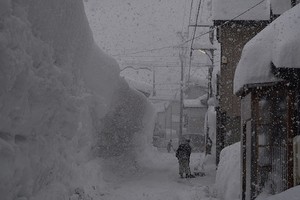By HIDEKI MOTOYAMA/ Staff Writer
January 23, 2023 at 18:16 JST
The Air Self-Defense Force is facing pressure to jettison its new aircraft logo amid criticisms from Ainu people indigenous to Hokkaido that it appropriates their culture.
One Ainu group is petitioning the force and the prime minister to have it removed, and experts say the issue shines a light on the lack of legal protections for indigenous cultural expressions.
The ASDF’s Second Air Wing, based in Chitose, Hokkaido, unveiled the new logo on Dec. 1 to be displayed on the vertical tail wings of its aircraft.
It features a brown bear’s head, a bird’s feathers and an arabesque design, with the central section using spiral patterns and diamond shapes.
According to an expert, the chosen design overlaps with the “basic shape of Ainu patterns.”
An ASDF representative said the design was decided based on ideas from members of the Second Air Wing.
Before announcing the logo, the Second Air Wing referred the design to related organizations such as the Ainu Association of Hokkaido, a public interest incorporated association based in Sapporo, and the Patent Office.
It confirmed there would be no problem with using the design, according to the representative, who said the logo was “newly created as a motif in keeping with the logo creator’s impression of and respect for Ainu culture.”
But there was no such mention of the Ainu in the Second Air Wing’s news release materials.
After the announcement, an Ainu man set off debate on social media when he tweeted that the logo is an “appropriation of Ainu culture.”
One scholar said since indigenous imagery is not protected under the law, people need to be careful about how they use it and seek consent.
“The culture of native people has not been protected by the Copyright Law,” said Yoko Shida, a professor of arts law at Musashino Art University. “But recently, there has been a debate that it should be protected as the intellectual property of a group. When the majority uses it, it needs to show respect to the parties concerned and should avoid careless appropriation of it against the will of the parties concerned.”
Shida pointed to the history of the Ainu people, who have long been exploited and discriminated against by Japanese colonizers.
“There are some among the Ainu people who react strongly against the SDF,” Shida said. “(The ASDF) should have been sensitive (to this).”
The Ainu Association of Hokkaido acknowledged it has little control over the use of these images.
“We told the SDF that we do not have the authority to grant the use of patterns,” said a representative of the association. “Under the current circumstances, anybody can use the patterns.”
In 2019, a law to promote policies related to the Ainu people was enacted, legally recognizing them as indigenous people in Japan. But the law has been criticized for falling short and the Ainu continue to struggle for autonomy.
The United Nations’ Declaration on the Rights of Indigenous Peoples, established in 2007, states that indigenous people have the right to manage and protect the traditional cultural expressions of indigenous people.
It also mentions the need for state safeguards.
But there is no system that governs commercial use of indigenous cultural expressions, aside from some private organizations that have taken their own steps.
The Citizens’ Alliance for the Examination of Ainu Policy, a Sapporo-based group of scholars and Ainu people, sent a letter on Jan. 16 to the headquarters of the Second Air Wing and to Prime Minister Fumio Kishida demanding the pattern not be used in the logo.
The group characterized the logo as an “act of undermining the rights of Ainu people” and said it “runs counter to the spirit of the U.N. declaration.”
Hiroshi Maruyama, a professor emeritus at Muroran Institute of Technology who specializes in policies related to indigenous people, said the government needs to create a system to prevent cultural appropriation.
“International public opinion on the appropriation of indigenous people’s cultures has become strong,” he said. “The current circumstance in which there is no system in place for determining use of the traditional culture of Ainu people is problematic. The central government needs to take a step based on the law.”




















A peek through the music industry’s curtain at the producers who harnessed social media to help their idols go global.
A series based on diplomatic documents declassified by Japan’s Foreign Ministry
Here is a collection of first-hand accounts by “hibakusha” atomic bomb survivors.
Cooking experts, chefs and others involved in the field of food introduce their special recipes intertwined with their paths in life.
A series about Japanese-Americans and their memories of World War II